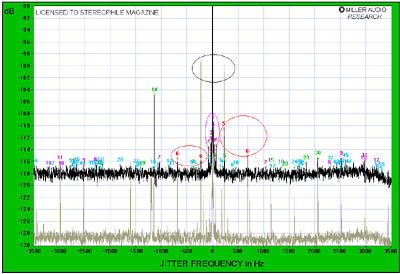| Columns Retired Columns & Blogs |
Radio Shack Optimus CD-3400 portable CD player More Jitter Measurements
Postscript: More Jitter Measurements
The solid trace in fig.10 is a high-resolution spectrum of the CD-3400's analog output made with the Miller Audio Research Jitter Analyzer several years after the Stereophile review was published. The player was decoding data representing a high-level 11.025kHz tone over which has been overlaid a low-frequency squarewave at the LSB level. The drive ran quite a bit slow, the absolute pitch being off by -651ppm, which explains Robert Harley's 1994 experience that the Audio Alchemy DTI•Pro was unable to lock to the CD-3400's S/PDIF signal.

Fig.10 RadioShack Optimus CD-3400, high-resolution jitter spectrum of analog output signal (11.025kHz at -6dBFS with LSB toggled at 229Hz). Center frequency of trace, 11.025kHz; frequency range, ±3.5kHz. Grayed-out trace is similar analysis for the RadioShack driving a Musical Fidelity X-24K DAC via a 6' Apature S/PDIF link.
While the noisefloor is high, the actual jitter level is respectably low at 404 picoseconds. The main components are data-related, at ±229Hz and its harmonics (red numerical markers and circles), related to the subcode frame rate (gray markers), or at low frequencies (purple markers and magenta circle). This trace was taken with the player's display light on. With it off, the jitter dropped to a very low 256ps, though the noisefloor rose very slightly!
The grayed-out trace in fig.10 was taken from the analog output of a Musical Fidelity X-24K D/A processor being driven by the CD-3400's digital output via 6' of S/PDIF cable. Note that the noisefloor has dropped by almost 12dB, implying that the CD-3400 really has about 14-bit dynamic range from its analog outputs, as implied in the 1994 measurements. The measured jitter level was 669ps, which is quite a bit higher than the Musical Fidelity achieves when driven by Class A transports. However, the jitter components are almost all data-related—the strong sidebands at ±229Hz are circled in black—which might be relatively subjectively innocuous.
In 2010, using the Audio Precision SYS2722 analyzer, I was able to directly measure the jitter in the CD-3400's digital output. (The CD-3400 was unusual for a portable in having a digital output, on a 3.mm jack.) To my surprise, the jitter was one of the lowest I have measured in an S/PDIF datastream, at just 295.8 picoseconds peak, with a correspondingly wide-open eye pattern. This test also confirmed the slight clock error, the 44,100Hz sample rate actually being 44,072Hz. This will not have audible consequences.—John Atkinson.
- Log in or register to post comments



































